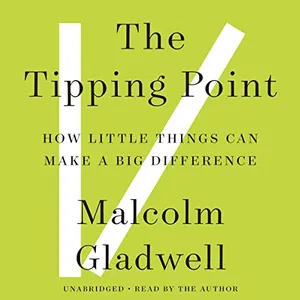
About 24 years ago a book was published by Little, Brown and Company, a long time Boston based publisher then owned by Time Inc. The book was “The Tipping Point”, by Malcom Gladwell, and at the time it was considered one of the most important books of the 21st Century. It’s one of my favorites.
The basic premises of this book are still completely relevant, despite it coming out prior to the rise and subsequent domination by social media for spreading information (Facebook was created in 2004, four years after The Tipping Point was published).
We all intuitively know what a tipping point is, and it’s an odd concept, especially in the physical world. A classic example is when you’re just sitting there on your couch watching TV and all of a sudden a painting falls off the wall, or a light bulb burns out. You could attribute it to ghosts, but what’s really happened is that the nail holding the painting finally fell out of the drywall, or the bulb finally reached the point where the filament burned out. It’s the kind of phenomena calculus was designed to predict, as things reach their limit, and for most of us, calculus is sort of supernatural anyway.
The tipping point describes how the equivalent of a painting falling off the wall happens in society. What starts a trend? Why do certain ideas catch on? It’s a concept that’s just as relevant now as it was then, although it’s become more controversial over time. I happen to think Malcom Gladwell got it mostly right, since it makes sense, but not everyone agrees.
Key to his ideas, and to my mind the most interesting concept, is how he categorized people into three groups, which working together push ideas and trends over the tipping point, making them popular, accepted, or a part of the culture. The categories of people are (and this sounds like Jeopardy)….Connectors, Mavens, and Salespeople. Mavens are the people who come up with new ideas, discover great deals or products, or have new opinions about things. Connectors are those who spread the word….these people are active on social media, know a lot of people personally, and enjoy connecting people. Salesmen are charismatic and thus convincing–that’s why they’re sales people.
It’s interesting to think about yourself, and which category you’d fit into. Personally, I’m sure I’m a connector. I know a lot of people…I can’t go into Vincent’s Country Store without running into at least three or four people I know, and I really like connecting people–that’s why I have a ‘recommended professionals’ page on my website. It’s a list of people I’ve worked with, and who did a good job for me, so I want to make sure others know about them. Why? It’s simply because I like to help people, and connecting them to someone who did a good job for me makes it more likely that they’ll do a good job for others too.
Jay, on the other hand, is more of a “maven”. He comes up with ideas I wouldn’t have thought of, is quite creative, but he doesn’t network at all like I do. In fact, he’s terrible at names. He’s constantly asking me what some person’s name is, that he’s met many times, and even played tennis with, but he simply doesn’t remember their name. As long as I’ve known him, he’s been telling me to introduce myself, because it would be awkward otherwise.
There’s more controversy around the ideas in the Tipping Point these days. For instance, in the Tipping Point, the drop in crime in New York City in the early 2000s was attributed to a strategy called the ‘broken windows’ theory…..keep the area looking better and clamp down on petty crime, and major crime will drop. That is exactly what happened, but others have since pointed out that the drop in crime correlated with both the ‘stop and frisk’ policy and a much greater police presence. It’s interesting that now we’re seeing the opposite–crime is spiking, but both explanations are still plausible…there’s much less police presence but also the environment has degraded considerably, making you wonder which is the reason (it’s probably both or something else). In any event the book is definitely worth reading. It gives you something to think about.
Having had a personal connection to Little, Brown and company, which published the Tipping Point, it’s interesting to speculate what the tipping point was for Little, Brown. The company was established in 1837, was independent until 1968 (131 years), when it was purchased by Time, Inc, which let it run independently. But then Time merged with Warner, which became TimeWarner in 1989. Then TimeWarner was purchased by AOL, becoming AOLTimeWarner, which was then purchased by Hachette, a large European publisher. Little, Brown and Company is now just an imprint, and the long-time headquarters, at 34 Beacon Street, has long since been sold.
I think the tipping point for Little, Brown was being purchased by AOL, which was fairly disastrous almost immediately, but you could also make the argument that the actual tipping point was much earlier, when Little, Brown ceased being independent.



